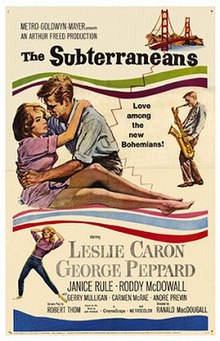
George Peppard was an American actor. He secured a major role as struggling writer Paul Varjak when he starred alongside Audrey Hepburn in Breakfast at Tiffany's (1961), and later portrayed a character based on Howard Hughes in The Carpetbaggers (1964). On television, he played the title role of millionaire insurance investigator and sleuth Thomas Banacek in the early-1970s mystery series Banacek. He played Col. John "Hannibal" Smith, the cigar-smoking leader of a renegade commando squad in the 1980s action television series The A-Team.

Beatniks were members of a social movement in the mid-20th century, who subscribed to an anti-materialistic lifestyle. They rejected the conformity and consumerism of mainstream American culture and expressed themselves through various forms of art, such as literature, poetry, music, and painting. They also experimented with spirituality, drugs, sexuality, and travel. The term "beatnik" was coined by San Francisco Chronicle columnist Herb Caen in 1958, as a derogatory label for the followers of the Beat Generation, a group of influential writers and artists who emerged during the era of the Silent Generation's maturing, from as early as 1946, to as late as 1963, but the subculture was at its most prevalent in the 1950s. This lifestyle of anti-consumerism may have been influenced by their generation living in extreme poverty in the Great Depression during their formative years, seeing slightly older people serve in WWII and being influenced by the rise of left-wing politics and the spread of Communism. The name was inspired by the Russian suffix "-nik", which was used to denote members of various political or social groups. The term "beat" originally was used by Jack Kerouac in 1948 to describe his social circle of friends and fellow writers, such as Allen Ginsberg, William S. Burroughs, and Neal Cassady. Kerouac said that "beat" had multiple meanings, such as "beaten down", "beatific", "beat up", and "beat out". He also associated it with the musical term "beat", which referred to the rhythmic patterns of jazz, a genre that influenced many beatniks.

The Beat Generation was a literary subculture movement started by a group of authors whose work explored and influenced American culture and politics in the post-World War II era. The bulk of their work was published and popularized by Silent Generationers in the 1950s, better known as Beatniks. The central elements of Beat culture are the rejection of standard narrative values, making a spiritual quest, the exploration of American and Eastern religions, the rejection of economic materialism, explicit portrayals of the human condition, experimentation with psychedelic drugs, and sexual liberation and exploration.

André George Previn was a German-American pianist, composer, and conductor. His career had three major genres: Hollywood films, jazz, and classical music. In each he achieved success, and the latter two were part of his life until the end. In movies, he arranged and composed music. In jazz, he was a celebrated trio pianist, a piano-accompanist to singers of standards, and pianist-interpreter of songs from the "Great American Songbook". In classical music, he also performed as a pianist but gained television fame as a conductor, and during his last thirty years created his legacy as a composer of art music.

Gerald Joseph Mulligan, also known as Jeru, was an American jazz saxophonist, clarinetist, composer and arranger. Though primarily known as one of the leading jazz baritone saxophonists—playing the instrument with a light and airy tone in the era of cool jazz—Mulligan was also a significant arranger working with Claude Thornhill, Miles Davis, Stan Kenton, and others. His piano-less quartet of the early 1950s with trumpeter Chet Baker is still regarded as one of the best cool jazz ensembles. Mulligan was also a skilled pianist and played several other reed instruments. Several of his compositions including "Walkin' Shoes" and "Five Brothers", have become standards.
Leroy Vinnegar was an American jazz bassist. Born in Indianapolis, Indiana, United States, the self-taught Vinnegar established his reputation in Los Angeles, California, during the 1950s and 1960s. His trademark was the rhythmic "walking" bass line, a steady series of ascending or descending notes, and it brought him the nickname "The Walker". Besides his jazz work, he also appeared on a number of soundtracks and pop albums, notably Van Morrison's 1972 album, Saint Dominic's Preview.

The Subterraneans is a 1958 novella by the Beat Generation author Jack Kerouac. It is a semi-fictional account of his short romance with Alene Lee (1931–1991), an African-American woman, in Greenwich Village, New York. It was the first work of Kerouac’s to be released following the success of On the Road. The Subterraneans and its following novel,The Dharma Bums, both proved to be popular when released in 1958, and are now seen as important works of the Beat Literature. A Hollywood film adaptation would be released in 1960.
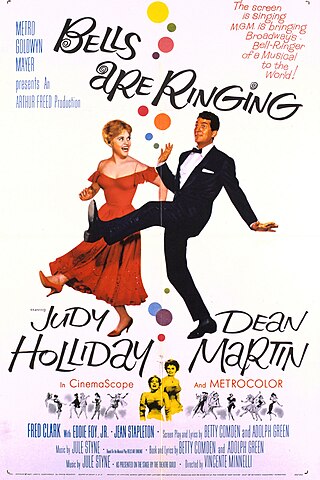
Bells Are Ringing is a 1960 American romantic comedy-musical film directed by Vincente Minnelli and starring Judy Holliday and Dean Martin. Based on the successful 1956 Broadway production of the same name by Betty Comden, Adolph Green and Jule Styne, the film focuses on Ella Peterson, based on the life of Mary Printz, who works in the basement office of a telephone answering service.
West Coast jazz refers to styles of jazz that developed in Los Angeles and San Francisco during the 1950s. West Coast jazz is often seen as a subgenre of cool jazz, which consisted of a calmer style than bebop or hard bop. The music relied relatively more on composition and arrangement than on the individually improvised playing of other jazz styles. Although this style dominated, it was not the only form of jazz heard on the American West Coast.
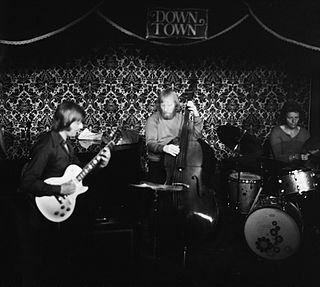
Keith Moore "Red" Mitchell was an American jazz double-bassist, composer, lyricist, and poet.

It's Always Fair Weather is a 1955 American musical satire directed by Gene Kelly and Stanley Donen. The film was scripted by Betty Comden and Adolph Green, who also wrote the show's lyrics, with music by André Previn. It stars Kelly, Dan Dailey, Cyd Charisse, Dolores Gray, and dancer/choreographer Michael Kidd in his first film acting role.
Robert Martin Enevoldsen was a West Coast jazz tenor saxophonist and valve trombonist born in Billings, Montana, known for his work with Marty Paich.
Joe Mondragon was an American jazz bassist.
Samuel David Bailey was an American jazz drummer.

Presenting the Gerry Mulligan Sextet is an album led by American jazz baritone saxophonist Gerry Mulligan featuring tracks recorded in 1955 and released on the EmArcy label.
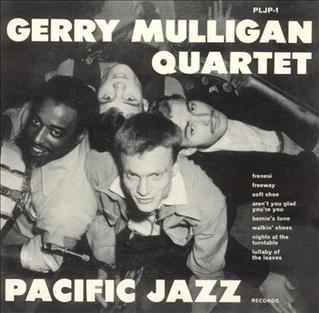
Gerry Mulligan Quartet Volume 1 is an album by saxophonist and bandleader Gerry Mulligan featuring performances recorded in 1952 and originally released as the first 10-inch LP on the Pacific Jazz label. In 2001 Pacific Jazz released an album on CD with additional tracks from Mulligan's first five recording sessions.

Lee Konitz Plays with the Gerry Mulligan Quartet is a compilation album by saxophonist and bandleader Gerry Mulligan's Quartet with Lee Konitz featuring performances recorded in early-1953. The records on the album were originally released on 10-inch LPs Lee Konitz Plays with the Gerry Mulligan Quartet and Lee Konitz and the Gerry Mulligan Quartet on Pacific Jazz Records along with previously unreleased tracks and alternate takes.

An Adventure in Sound: Reeds in Hi-Fi is an album by composer, arranger and conductor Pete Rugolo featuring performances recorded in 1956 and first released on the Mercury label in 1958.
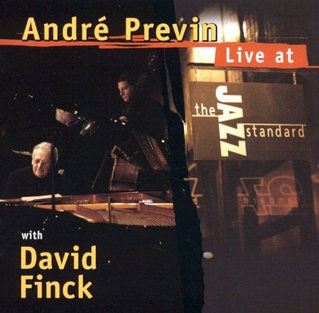
Live at the Jazz Standard is a 2001 album by André Previn accompanied by bassist David Finck recorded live at the Jazz Standard club in New York City.
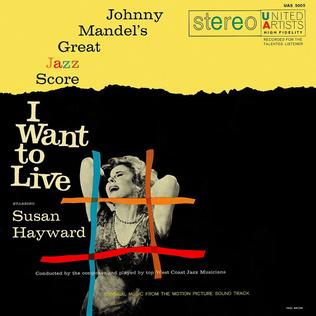
I Want to Live!' is the debut film score composed, arranged and conducted by Johnny Mandel, for the 1958 film of the same name directed by Robert Wise. In addition to Mandel's score, the film features jazz themes performed by Gerry Mulligan's Jazz Combo. Two soundtrack albums were released on the United Artists label in 1958. Mandel was nominated for the Grammy Award for Best Sound Track Album or Recording of Original Cast From a Motion Picture or Television at the inaugural 1st Annual Grammy Awards in 1959; he lost to André Previn's score for Gigi.
